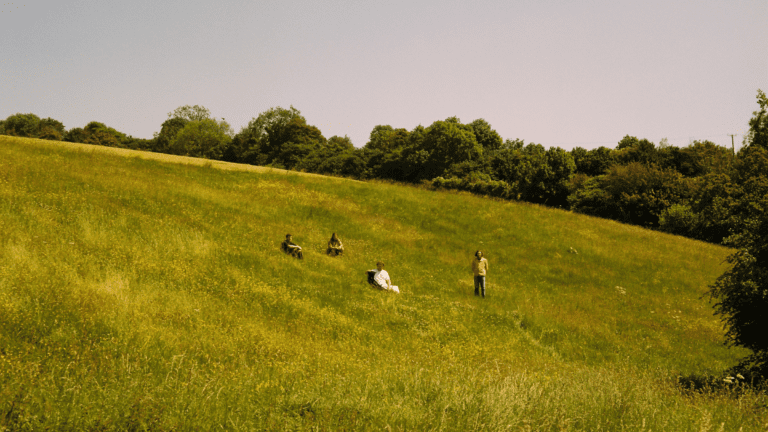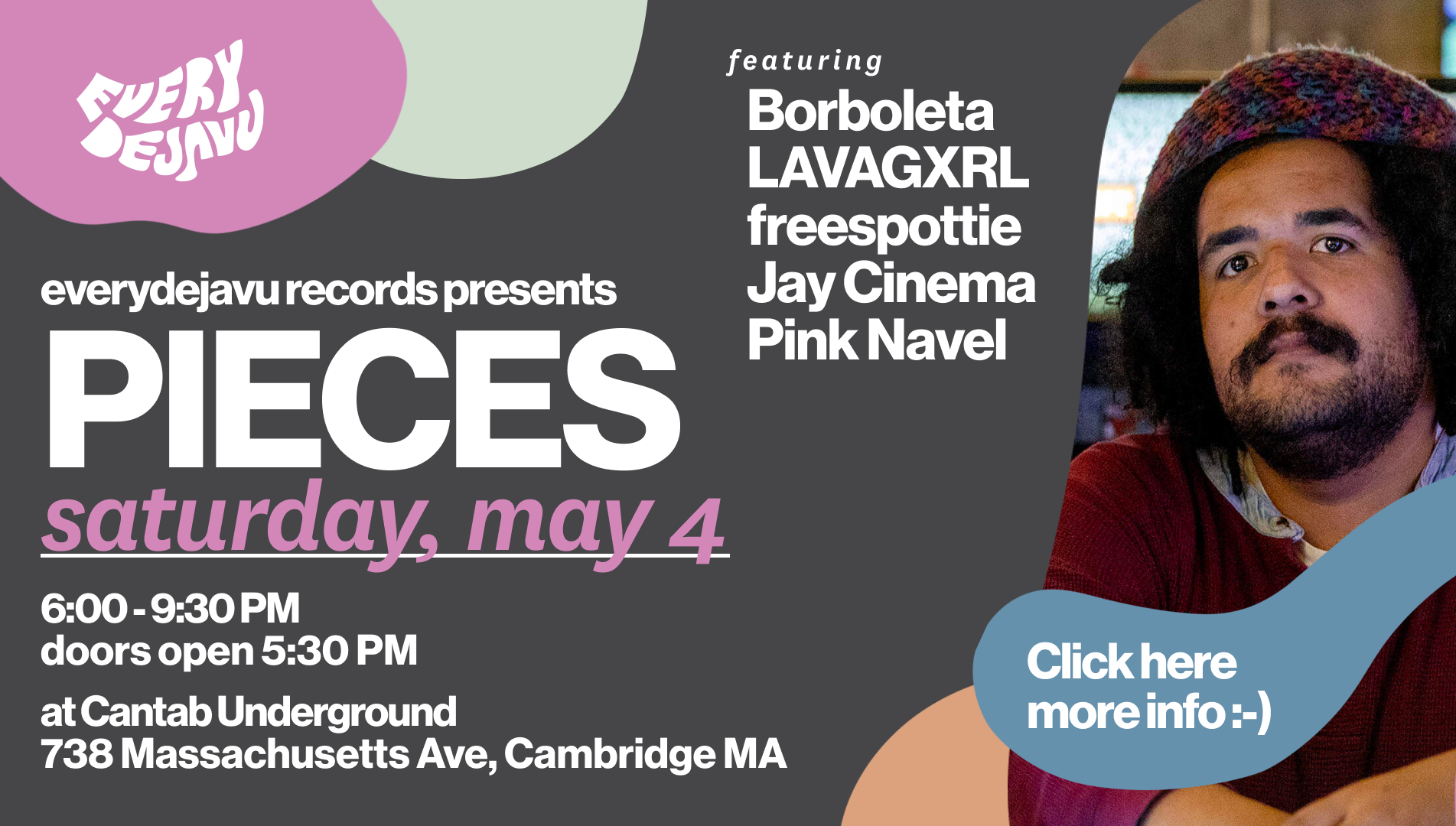Frenetic, experimental, and grounded. Quade is the experimental folk band born in lockdown outside Bath, UK, now based in Bristol, here to hold your hand and take you on an adventure with their debut album, Nacre, out today on AD 93. We met over Zoom, which gave us a glimpse into the familiar comforts of a 20-something-year-old’s bedroom: a generally humble ambiance. Opening up to us about their misadventures were bassist and vocalist Barney Matthews, violinist and guitarist Tom Connolly, and drummer Leo Fini; meanwhile, synthesist Matt Griffiths was stuck at work during our 4 PM tête-à-tête.
Quade is an invented name almost taken straight out of the air but has an intimate history. It’s about the band bonding together, away from their shared home of Bristol—on an adventure through the absolute whole of France. Quade is transplanted directly from the white Ford Escort’s name that seven years ago joined the four young men as they journeyed into the country known best for romance, cheese, and wine (with a fifth non-band member also in tow). “It was quite a scummy wild camping trip,” confides Matthews, “We’d be in the wilderness for like a week, then we’d turn up in Aix-en-Provence or somewhere like that just stinking.” Now, that is bohemian. The band’s name brings up a back-to-basics lifestyle that lets the core pleasures of life rise to the surface. The morning sunshine on your face, the awe-inspiring nature that wild camping often helps you stop and look at for that little bit longer, and the joy of great company. Quade encompasses this: shared freedom and adventure without frills.
Exploration seems to be a principal value of the band that melds dissonant drones with probing violin. Their sprawling, haunting yet hopeful album recalls expansive landscapes they have encountered over their lives—whether locally or afield. “It does revolve around this strong sense of place,” declares Connolly of Nacre. And one song in particular is actually the name of a place, “Piles Copse.” It’s an ancient English oak woodland in the Erme valley on Southern Dartmoor. Fini explained, “I don’t know how we got there; I think we were just driving,” clearly on an adventure. “We ended up going for quite a long walk through the really amazing ancient woodlands, and there was a dark red-tinged river flowing by the woodland where we went for a swim. It was very magical and inspiring.” The fabulous surroundings melt into the track, the tightly packed drum beats mirroring the dense forest and swirling violin evoking the river.
But it wasn’t all beauty—there is a darkness in nature, he adds, “We saw a lamb or a sheep that clearly had some gnarly infection or injury that was on its back looking upwards. It was very graphic with its eyes bleeding, sprawling around.” Quite traumatizing for the band, “It was quite an intense and disturbing thing for us all to see. I think the song has something to do with the magicness of the woodlands and the disturbing scenes of the writhing sheep.” This jazzy experimental drum-led piece is highly contemporary, with its haunting synths circling to the beat and echoing lyrics. It sounds like a new score for the cyclone sequence in The Wizard of Oz. Panicked and breathless, the hurly burley of the track whisks us away to this impressive British landscape—inspired by magic and unsettling scenes. On the track, ominously, Matthews repeats, “People won’t believe what I’ve seen” through the backdrop of electric guitar, turbulent synth drone, and pattering drums. The song is a moody winner that sets the scene of landscapes.
In our chat, Connolly paints a picture of the band’s sonic environment, “There’s a strong Celtic angle to it, but there’s also something urban about it.” The fiddle’s grand and far-reaching folk elements greet the mechanized synth harmoniously in Nacre. Place drips into the album’s themes, which was partly written in St. Catherine’s Valley outside Bath—Fini’s home. It all started there, in a run-down shed in Fini’s garden. “The Valley has probably shaped it to an extent,” utters Matthews. These lush, green, and ancient environs imbue the album with its sense of isolation and charm. Nacre happily slips between gothic expansiveness and cosmic psychedelia—so it’s certainly not limited to the confines of space, although it is important. “Of The Source” feels simultaneously romantic and mournful—like a beautiful English small town—in its opening, then gets its groovy psychedelic boots on in the middle and plays coolly out with the fiddle arching its back like a black cat on your neighbor’s wall at dusk. During lockdown, people’s connections with the natural world grew, particularly for those lucky enough to have access to it. Connolly admits, “The fantastical quality was probably some kind of lockdown escapism as well.” Fini chimes in, “Pretty much all we do is escaping.” So, psychedelia has its place in the British countryside.
While the Quade recently went to Wales to write some new music, the presence of Bristol remains insuppressibly significant in their collective imagination. It’s home. The city is great for catching international talents on tour but also has a wonderful homegrown scene with a “genuine community,” Matthews explained. From serious noise weirdos to folk singer-songwriters, Bristol has a corner for every genre in its vast array of gig venues—the best of which seem concentrated in Stokes Croft. Within that community of ragtag music-enjoyers and creators is Jack Ogbourne of Bingo Fury, who engineered the album, and Lary ‘Bruce’ McCarthy, who mixed it. Many other scenesters—such as Rafi Cohen of Sunglasz Vendor—feature on a montage at the start of one of the songs on Nacre made by Matt Griffiths. The list of inspiring acts goes on—for some contemporaries, there is O.G. Jigg and Foot Foot. The very existence of Nacre reflects the support they have seen from the scene with its confident experimentalism that is so cherished in the city.
Duality is another theme in the city and the album. There’s both a band and electronic scene in Bristol that has influenced Quade quite a lot. Additionally, there’s the urban environment with easy access to the countryside. Some might say the secret to life is all in crumbling the boundaries of duality, as exemplified in “The Balance.” It is one of Quade’s most familiar and successful songs, having soundtracked the Dior Autumn/Winter Haute Couture show in 2021. There’s a cavernous, pure yet gritty energy to the dainty fiddle that contrasts with the grooving bass; the track is truly one of the greats by Quade.
Another dualism in the album is comfort and discomfort. When recording, Quade went to an iconic venue in Bristol, The Louisiana, and dived into the basement. “It’s very small with absolutely no light. It added a slightly frenetic quality at times. My claustrophobia got the better of me a couple of times. You might be able to hear that,” Connolly shared. Comfortingly fuelled by decaf Earl Grey and chocolate Leibniz biscuits in a familiar yet unfamiliar place (gigs at the Louisiana are usually upstairs), there nonetheless is a sense of stress and resilience in the noise of Nacre. Connolly’s fiddle dances with great control, but is there an underlying sense of anxiety?
The album is an absolute triumph that brings together a myriad of local European environmental touchstones: the sunshine of Aix-en-Provence, the disturbing winds of Piles Copse, the expansive nature surrounding St. Catherine’s Valley, and the tension of Bristol’s urban and countryside. Nacre is a musical journey that encapsulates all this, creating an unrivaled sonic map of places that have touched the band.
See the magic unfurl at Quade’s album launch party on the 23rd.





